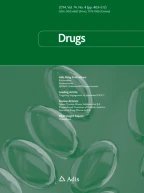Abstract
▴ Pegaptanib, an aptamer, is an antagonist of vascular endothelial growth factor that has shown efficacy in the treatment of patients with exudative age-related macular degeneration (AMD).
▴ In two randomised, double-masked trials in patients with exudative AMD (n = 1208), the proportion of responders (those losing <15 letters of visual acuity) at 54 weeks was significantly higher in intravitreous pegaptanib 0.3mg recipients than in those receiving sham injections (70% vs 55%; p < 0.001). These trials were conducted concurrently and analysed as a single study; the treatments were given every 6 weeks for 48 weeks. The improvement in visual acuity with pegaptanib was maintained in a 1-year extension of these trials.
▴ Similar favourable results with pegaptanib 0.3mg were seen in terms of the secondary efficacy endpoints (e.g. proportion of patients experiencing severe loss of visual acuity or legal blindness in the study eye). These vision-improving effects of pegaptanib were associated with beneficial angiographic effects.
▴ Intravitreous pegaptanib 0.3–3mg was well tolerated with most ocular adverse events being mild-tomoderate and transient. Serious injection-related adverse events occurred in ≤1.3% of patients treated with pegaptanib. There were no systemic adverse events that could be definitely attributed to pegaptanib.
Similar content being viewed by others
Notes
The use of trade names is for product identification purposes only and does not imply endorsement.
References
Hooper CY, Guymer RH. New treatments in age-related macular degeneration. Clin Experiment Ophthalmol 2003; 31(5): 376–91
Kim RW, Heier JS. Innovative treatments for exudative age-related macular degeneration. Int Ophthalmol Clin 2004; 44(4): 41–50
Bressler NM, Bressler SB, Congdon NG, et al. Potential public health impact of Age-Related Eye Disease Study results: AREDS report no. 11. Arch Ophthalmol 2003; 121(11): 1621–4
Bressler NM. Age-related macular degeneration is the leading cause of blindness…. JAMA 2004; 291(15): 1900–1
Comer GM, Ciulla TA, Criswell MH, et al. Current and future treatment options for nonexudative and exudative age-related macular degeneration. Drugs Aging 2004; 21(15): 967–92
Seddon JM, Chen CA. The epidemiology of age-related macular degeneration. Int Ophthalmol Clin 2004; 44(4): 17–39
Friedman DS, O’Colmain BJ, Munoz B, et al. Prevalence of age-related macular degeneration in the United States. Arch Ophthalmol 2004; 122(4): 564–72
Macular Photocoagulation Study Group. Argon laser photocoagulation for neovascular maculopathy: five-year results from randomized clinical trials. Arch Ophthalmol 1991; 109(8): 1109–14
Treatment of Age-related macular degeneration with Photodynamic therapy (TAP) Study Group. Photodynamic therapy of subfoveal choroidal neovascularization in age-related macular degeneration with verteporfin: one-year results of 2 randomized clinical trials — TAP report. Arch Ophthalmol 1999; 117(10): 1329–45
Singerman LJ, for the Macugen Diabetic Retinopathy Study Group. Safety and efficacy of pegaptanib sodium (Macugen™) in patients with diabetic macular edema: results of the phase 2 trial [abstract]. The 28th Annual Macula Society Meeting; 2005 Feb 23–26; Key Biscayne, FL
Bell C, Lynam E, Landfair DJ, et al. Oligonucleotide NX1838 inhibits VEGF165-mediated cellular responses in vitro. In Vitro Cell Dev Biol Anim 1999; 35(9): 533–42
Eyetech Study Group. Preclinical and phase 1A clinical evaluation of an anti-VEGF pegylated aptamer (EYE001) for the treatment of exudative age-related macular degeneration. Retina 2002 Apr; 22: 143–52
Robinson CJ, Stringer SE. The splice variants of vascular endothelial growth factor (VEGF) and their receptors. J Cell Sci 2001; 114(5): 853–65
Spilsbury K, Garrett KL, Shen WY, et al. Overexpression of vascular endothelial growth factor (VEGF) in the retinal pigment epithelium leads to the development of choroidal neovascularization. Am J Pathol 2000; 157(1): 135–44
Guyer DR, Fish G, Haller JA, et al. Anti-vascular endothelial growth factor therapy for subfoveal choroidal neovascularization secondary to age-related macular degeneration: phase II study results. Ophthalmology 2003; 110(5): 979–86
Eyetech Pharmaceuticals Inc./Pfizer Inc. Product information: Macugen® (pegaptanib sodium injection) 0.3mg [online]. Available from URL: http://www.macugen.com [Accessed 2005 Jun 8]
Capone A, for the Macugen AMD Study Group. Safety and pharmacokinetics of intravitreous pegaptanib sodium (Macugen®) in patients with exudative age-related macular degeneration (AMD) [abstract]. The 28th Annual Macula Society Meeting; 2005 Feb 23–26; Key Biscayne, FL
Drolet DW, Nelson J, Tucker CE, et al. Pharmacokinetics and safety of an anti-vascular endothelial growth factor aptamer (NX1838) following injection into the vitreous humor of rhesus monkeys. Pharm Res 2000 Dec; 17: 1503–10
Gragoudas ES, Adamis AP, Cunningham Jr ET, et al. Pegaptanib for neovascular age-related macular degeneration. N Engl J Med 2004 Dec 30; 351(27): 2805–16
D’Amico DJ, for the VEGF inhibition study in ocular neovascularisation (VISION) clinical trials group. Second year efficacy data from the VISION study [abstract]. The 28th Annual Macula Society Meeting; 2005 Feb 23–26; Key Biscayne, FL
Mieler WF, for the VEGF inhibition study in ocular neovascularisation (VISION) clinical trials group. VEGF inhibition study in ocular neovascularisation (VISION): safety assessment of second year treatment with Macugen™ (pegaptanib sodium) for AMD [abstract]. The 28th Annual Macula Society Meeting; 2005 Feb 23–26; Key Biscayne, FL
Author information
Authors and Affiliations
Corresponding author
Rights and permissions
About this article
Cite this article
Siddiqui, M.A.A., Keating, G.M. Pegaptanib. Drugs 65, 1571–1577 (2005). https://doi.org/10.2165/00003495-200565110-00010
Published:
Issue Date:
DOI: https://doi.org/10.2165/00003495-200565110-00010
